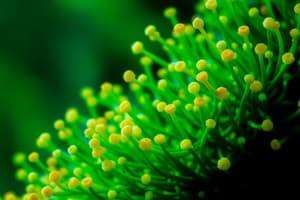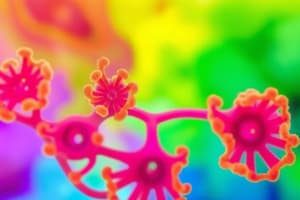Podcast
Questions and Answers
Algae are composed of members that have prokaryotic (e.g. Chlamydomonas) and eukaryotic type (e.g. Chroococcus) of cells.
Algae are composed of members that have prokaryotic (e.g. Chlamydomonas) and eukaryotic type (e.g. Chroococcus) of cells.
False (B)
Microalgae (e.g. Chlorella) can only be observed under a microscope while macroalgae (e.g. Sargassum) can be seen with the naked eye.
Microalgae (e.g. Chlorella) can only be observed under a microscope while macroalgae (e.g. Sargassum) can be seen with the naked eye.
True (A)
Filamentous algae (e.g. Chlorococcum) are composed of cells that are in the form of a chain while a colonial algae (e.g. Volvox) are composed of cells that can appear as organized mass.
Filamentous algae (e.g. Chlorococcum) are composed of cells that are in the form of a chain while a colonial algae (e.g. Volvox) are composed of cells that can appear as organized mass.
False (B)
Chlorophyll a absorbs the red and blue wavelengths while reflecting the green wavelenght of visible light.
Chlorophyll a absorbs the red and blue wavelengths while reflecting the green wavelenght of visible light.
The blue-green (e.g. Gloeocapsa), red (e.g. Caulerpa) and brown (e.g. Macrocystis) color of some algae are due to the masking of the green Chlorophyll a by different accessory pigments.
The blue-green (e.g. Gloeocapsa), red (e.g. Caulerpa) and brown (e.g. Macrocystis) color of some algae are due to the masking of the green Chlorophyll a by different accessory pigments.
In the diplontic life cyle, the only free-living multicellular stage is the diploid stage which assigns specific cells to undergo meiosis to produce sex cells or gametes.
In the diplontic life cyle, the only free-living multicellular stage is the diploid stage which assigns specific cells to undergo meiosis to produce sex cells or gametes.
In a diplo-haplontic biphasic life cycle, the zygote undergoes mitotis to produce a multicellular diploid generation called a gametophyte which in turn undergoes meiosis to produce haploid spores that will germinate to produce a multicellular haploid generation called a sporophyte.
In a diplo-haplontic biphasic life cycle, the zygote undergoes mitotis to produce a multicellular diploid generation called a gametophyte which in turn undergoes meiosis to produce haploid spores that will germinate to produce a multicellular haploid generation called a sporophyte.
In a diplo-haplontic triphasic life cycle, the alternating multicellular stages are the diploid carposporophyte stage, diploid tetrasporophyte stage and the haploid gametophyte stage.
In a diplo-haplontic triphasic life cycle, the alternating multicellular stages are the diploid carposporophyte stage, diploid tetrasporophyte stage and the haploid gametophyte stage.
Thallus-bodied algae (e.g. Laminaria) have plant-like parts (root-like stipe, stem-like holdfast and leaf-like blade) that are not considered as true organs because of the absence of vascular tissues.
Thallus-bodied algae (e.g. Laminaria) have plant-like parts (root-like stipe, stem-like holdfast and leaf-like blade) that are not considered as true organs because of the absence of vascular tissues.
The blue-green algae are classified under Division Cyanophyta and Kingdom Eubacteria while red algae are classified under Division Rhodophyta and Kingdom Plantae.
The blue-green algae are classified under Division Cyanophyta and Kingdom Eubacteria while red algae are classified under Division Rhodophyta and Kingdom Plantae.
The euglenoids are classified under Division Euglenophyta and Kingdom Plantae while the dinoflagellates are classified under Division Dinophyta and Kingdom Chromista.
The euglenoids are classified under Division Euglenophyta and Kingdom Plantae while the dinoflagellates are classified under Division Dinophyta and Kingdom Chromista.
The red algae are a product of the primary endosymbiosis between a heterotrophic eukaryote and a cyanobacteria which later became its chloroplast.
The red algae are a product of the primary endosymbiosis between a heterotrophic eukaryote and a cyanobacteria which later became its chloroplast.
The euglenoids are a product of the secondary endosymbiosis between a heterotrophic eukaryote and a eukaryotic red algae which later became its chloroplast.
The euglenoids are a product of the secondary endosymbiosis between a heterotrophic eukaryote and a eukaryotic red algae which later became its chloroplast.
Flashcards
Algae Composition
Algae Composition
Algae include both prokaryotic and eukaryotic members.
Size of Algae
Size of Algae
Microalgae require a microscope, whereas macroalgae can be seen without one.
Algae Structures
Algae Structures
Filamentous algae form chains, while colonial algae appear as organized masses.
Chlorophyll a Function
Chlorophyll a Function
Signup and view all the flashcards
Algae Coloration
Algae Coloration
Signup and view all the flashcards
Diplontic Life Cycle
Diplontic Life Cycle
Signup and view all the flashcards
Diplo-Haplontic Life Cycle
Diplo-Haplontic Life Cycle
Signup and view all the flashcards
Diplo-Haplontic Triphasic Life Cycle
Diplo-Haplontic Triphasic Life Cycle
Signup and view all the flashcards
Thallus-bodied Algae
Thallus-bodied Algae
Signup and view all the flashcards
Algae Classification
Algae Classification
Signup and view all the flashcards
Euglenoids Classification
Euglenoids Classification
Signup and view all the flashcards
Red Algae Origin
Red Algae Origin
Signup and view all the flashcards
Euglenoids Endosymbiosis
Euglenoids Endosymbiosis
Signup and view all the flashcards
Study Notes
- Algae includes prokaryotic and eukaryotic members, but Chlamydomonas is a genus including eukaryotic members, and Chroococcus includes prokaryotic members.
- Microalgae like Chlorella can only be observed under a microscope.
- Macroalgae like Sargassum can be seen with the naked eye.
- Filamentous algae like Ulothrix are composed of cells in a chain.
- Colonial algae like Volvox are composed of cells that appear as organized mass.
- Chlorophyll a absorbs red and blue wavelengths, reflecting green wavelengths of visible light.
- Blue-green algae (e.g., Gloeocapsa), red algae (e.g., Gracilaria), and brown algae (e.g., Macrocystis) colors result from masking green Chlorophyll a with different accessory pigments.
- In the diplontic life cycle, the only free-living multicellular stage is diploid.
- The diploid stage assigns specific cells to undergo meiosis to produce sex cells or gametes.
- In a diplo-haplontic biphasic life cycle, the zygote undergoes mitosis to produce a multicellular diploid generation called a sporophyte.
- The sporophyte then undergoes meiosis to produce haploid spores that germinate into a multicellular haploid generation called a gametophyte.
- A diplo-haplontic triphasic life cycle includes alternating multicellular stages of diploid carposporophyte, diploid tetrasporophyte, and haploid gametophyte stages.
- Thallus-bodied algae like Laminaria have plant-like parts, with a root-like holdfast, stem-like stipe, and leaf-like blade.
- These plant-like parts are not considered true organs due to the absence of vascular tissues.
- Blue-green algae are classified under Division Cyanophyta and Kingdom Eubacteria.
- Red algae are classified under Division Rhodophyta and Kingdom Plantae.
- Euglenoids are classified under Division Euglenophyta and Kingdom Protozoa.
- Dinoflagellates are classified under Division Dinophyta and Kingdom Chromista.
- Red algae are a product of primary endosymbiosis between a heterotrophic eukaryote and a cyanobacterium, which became its chloroplast.
- Euglenoids resulted from secondary endosymbiosis between a heterotrophic eukaryote and a eukaryotic green algae, which became its chloroplast.
Studying That Suits You
Use AI to generate personalized quizzes and flashcards to suit your learning preferences.




